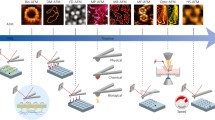Abstract
The atomic force microscope (AFM) was developed by modifying the scanning tunneling microscope (STM). It has high resolution on the subnanometer scale (10−10 m), does not require troublesome preprocessing of the sample, and permits observation of living samples. With these attractive features, the AFM is expected to be a new research tool in the field of artificial organs in the near future. This review describes the history and mechanism of the AFM and some of our observations of biological samples.
Similar content being viewed by others
References
Binnig G, Rohrer H, Gerber Ch, Weibel E. 7×7 reconstruction on Si(111) resolved in real space. Phys Rev Let 1983;50:120–123
Binnig G, Quate CF, Gerber C. Atomic force microscopy. Phys Rev Let 1986;56:930–933
Zachee P, Snauwaert J, Vandenberche P, Hellemans L, Boogaerts M. Imaging red blood cells with the atomic force microscope. Br J Haematol 1996;95:472–481
Zhang PC, Bai C, Huang YM, Zhao H, Fang Y, Wang NX, Li Q. Atomic force microscopy study of fine structures of the entire surface of red blood cells. Scanning Microsc 1995;9:981–988
Argaman M, Golan R, Thomson NH, Hansma HG. Phase imaging of moving DNA molecules and DNA molecules replicated in the atomic force microscope. Nucl Acids Res 1997;25:4379–4384
Hansma HG, Laney DE, Bezanilla M, Sinsheimer RL, Hansma PK. Applications for atomic force microscopy of DNA. Biophys J 1995;68:1672–1677
Vesenka J, Manne S, Yang G, Bustamante CJ, Henderson E. Humidity effects on atomic force microscopy of gold-labeled DNA on mica. Scanning Microsc 1993;7:781–788
Shaiu WL, Larson DD, Vesenka J, Henderson E. Atomic force microscopy of oriented linear DNA molecules labeled with 5 nm gold spheres. Nucl Acids Res 1993;21:99–103
Lyubchenko YL, Gall AA, Shlyakhtenko LS, Rodney E. Atomic force microscopy imaging of double standard DNA and RNA. J Biomol Struct Dynam 1992;10:589–606
Yoshida K, Yoshimoto M, Sasaki K, Ohnishi T, Ushiki T, Hitomi J, Yamamoto S, Shigeno M. Fabrication of a new substrate for atomic force microscopic observation of DNA molecules from an ultrasmooth sapphire plate. Biophys J 1998;74:1654–1657
Hansma HG, Vesenka J, Siegerist C, Kelderman G, Morrett H, Shinsheimer RL, Elings V, Bustamante C, Hansma PK. Reproducible imaging and dissection of plasmid DNA under liquid with the atomic force microscope. Science 1992;256:1180–1183
Shaiu WL, Larson DD, Vesenka J, Henderson E. Atomic force microscopy of oriented linear DNA molecules labeled with 5 nm gold spheres. Nucl Acids Res 1993;21(1):99–103
Kasas S, Gotzos V, Celio MR. Observation of living cells using the atomic force microscope. Biophys J 1993;64:539–544
Grimellec CL, Lesniewska E, Giocondi MC, Finot E, Vie V, Goudonnet JP. Imaging of the surface of living cells by low-force contact-mode atomic force microscopy. Biophys J 1998;75:695–703
Schneider SW, Sritharan KC, Geibel JP, Oberleithner H, Jena BP. Surface dynamics in living acinar cells imaged by atomic force microscopy: identification of plasma membrane structures involved in exocytosis. Proc Natl Acad Sci USA 1997;94:316–321
Kuznetsov TG, Malkin AJ, McPherson A. Atomic force microscopy studies of living cells: visualization of motility, division, aggregation, transformation, and apoptosis. J Struct Biol 1997;120:180–191
Nagayama S, Morimoto M, Kawabata K, Fujito Y, Ogura S, Abe K, Ushiki T, Ito E. AFM observation of three-dimensional fine structural changes in living neurons. Bioimages 1996;4(3):111–116
Schaus SS, Henderson ER. Cell viability and probe-cell membrane interactions of XR1 glial cells imaged by atomic force microscope. Biophys J 1997;73:1205–1214
Schoenenberger CA, Hoh JH. Slow cellular dynamics in MDCK and R5 cells monitored by time-lapse atomic force microscopy. Biophys J 1994;67:929–936
Kasas S, Ikai A. A method for anchoring round shaped cells for atomic force microscope imaging. Biophys J 1995;68:1678–1680
Allen S, Chen X, Davis J, Davies MC, Dawkes AC, Edwards JC, Roberts CJ, Sefton J, Tendler SJB, Williams PM. Detection of antigen-antibody binding events with the atomic force microscope. Biochemistry 1997;36:7457–7463
Willemsen OH, Snel MME, van der Werf KO, Grooth BG, Greve J, Hinterdorfer P, Gruber HJ, Schindler H, Kooyk Y, Figdor CG. Simultaneous height and adhesion imaging of antibody-antigen interactions by atomic force microscopy. Biophys J 1998; 75:2220–2228
Hinterdorfer P, Baumgartner W, Gruber HJ, Schilcher K, Schindler H. Detection and localization of individual antibody-antigen recognition events by atomic force microscopy. Proc Natl Acad Sci USA 1996;93:3477–3481
Dammer U, Hegner M, Anselmetti D, Wagner P, Dreier M, Huber W, Guntherodt HJ. Specific antigen/antibody interactions measured by force microscopy. Biophys J 1996;70:2437–2441
Stuart JK, Hlady V. Reflection interference contrast microscopy combined with scanning force microscopy verifies the nature of protein-ligand interaction force measurements. Biophys J 1999;76:500–508
Florin EL, Moy VT, Gaub HE. Adhesion force between individual ligand-receptor pairs. Science 1994;264:415–417
Lee GU, Kidwell DA, Colton RJ. Sensing discrete streptavidinbiotin interactions with atomic force microscopy. Langmuir 1994; 10:354–357
A-Hassan E, Heintz WF, Antonik MD, D'Costa NP, Nageswaran S, Schoenenberger CA, Hoh JH. Relative microelastic mapping of living cells by atomic force microscopy. Biophys J 1998;74:1564–1578
Almqvist N, Backman L, Fredriksson S. Imaging human erythrocyte spectrin with atomic force microscope. Micron 1994;25(3): 227–232
Takeuchi M, Miyamoto H, Sako Y, Komizu H, Kusumi A. Structure of the erythrocyte membrane skeleton as observed by atomic force microscopy. Biophys J 1998;74:2171–2183
Okamoto H, Kanno M, Ohta Y, Okuda T. Imaging of the spectrin network of red blood cell by an atomic force microscope. Third World Congress of Biomechanics 1998:488
Putman CAJ, Grooth BG, Hansma PK, Hulst NF, Greve J. Immunogold labels: cell-surface markers in atomic force microscopy. Ultramicroscopy 1993;48:177–182
Thimonier J, Montixi C, Chauvin P, He HT, Rocca-Serra J, Barbet J. Thy-1 immunolabeled thymocyte microdomains studied with the atomic force microscope and the electrom microscope. Biophys J 1997;73:1627–1632
Ohta Y, Okamoto H, Kanno M, Okuda T. Morphological changes of sheep red blood cell by loading with shear stress: imaging by atomic force microscope in nanometer scale. Int J Artif Organs 1998;21:598
Author information
Authors and Affiliations
Corresponding author
Rights and permissions
About this article
Cite this article
Ohta, Y., Okamoto, H., Okuda, T. et al. The atomic force microscope: a new tool for artificial organ research. J Artif Organs 2, 131–134 (1999). https://doi.org/10.1007/BF02480055
Received:
Issue Date:
DOI: https://doi.org/10.1007/BF02480055




